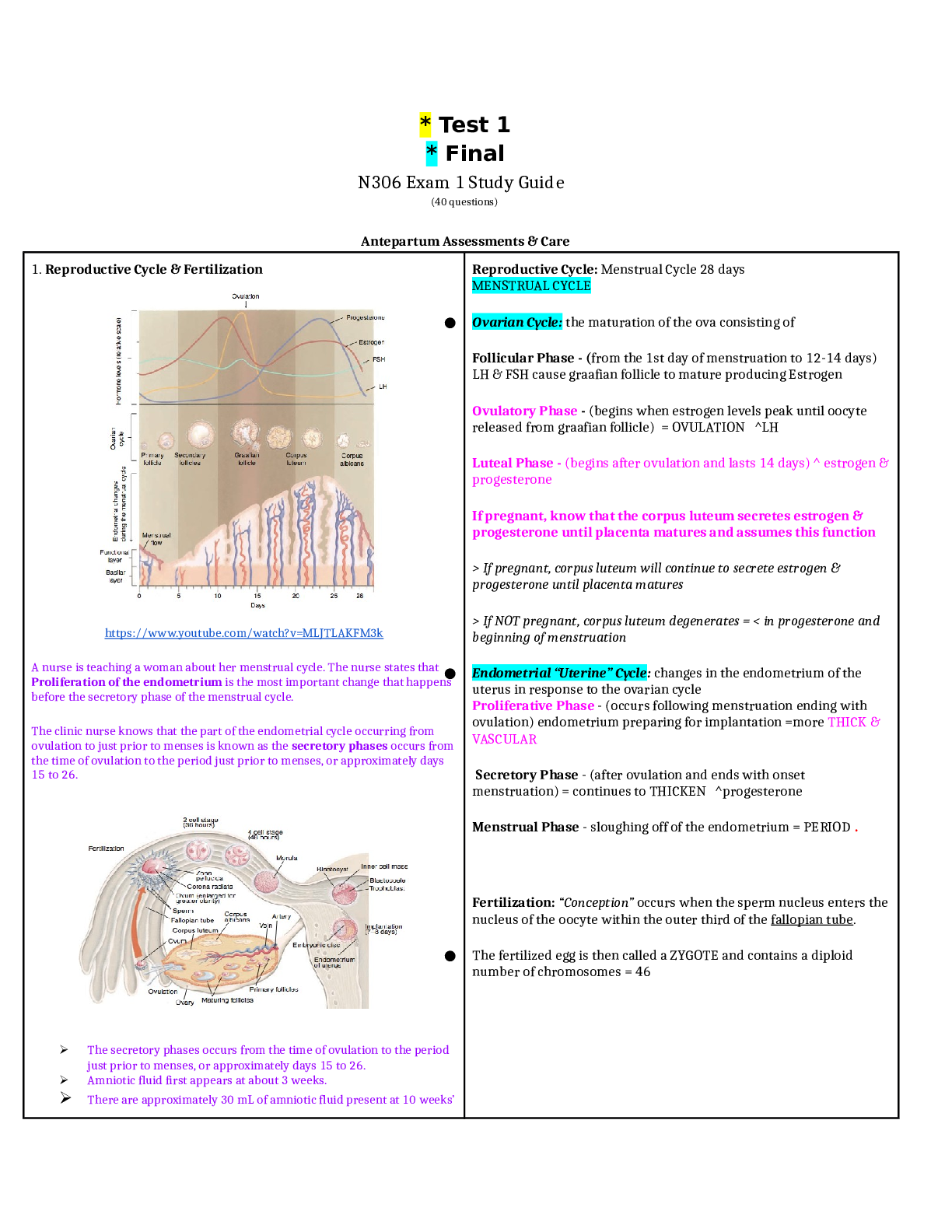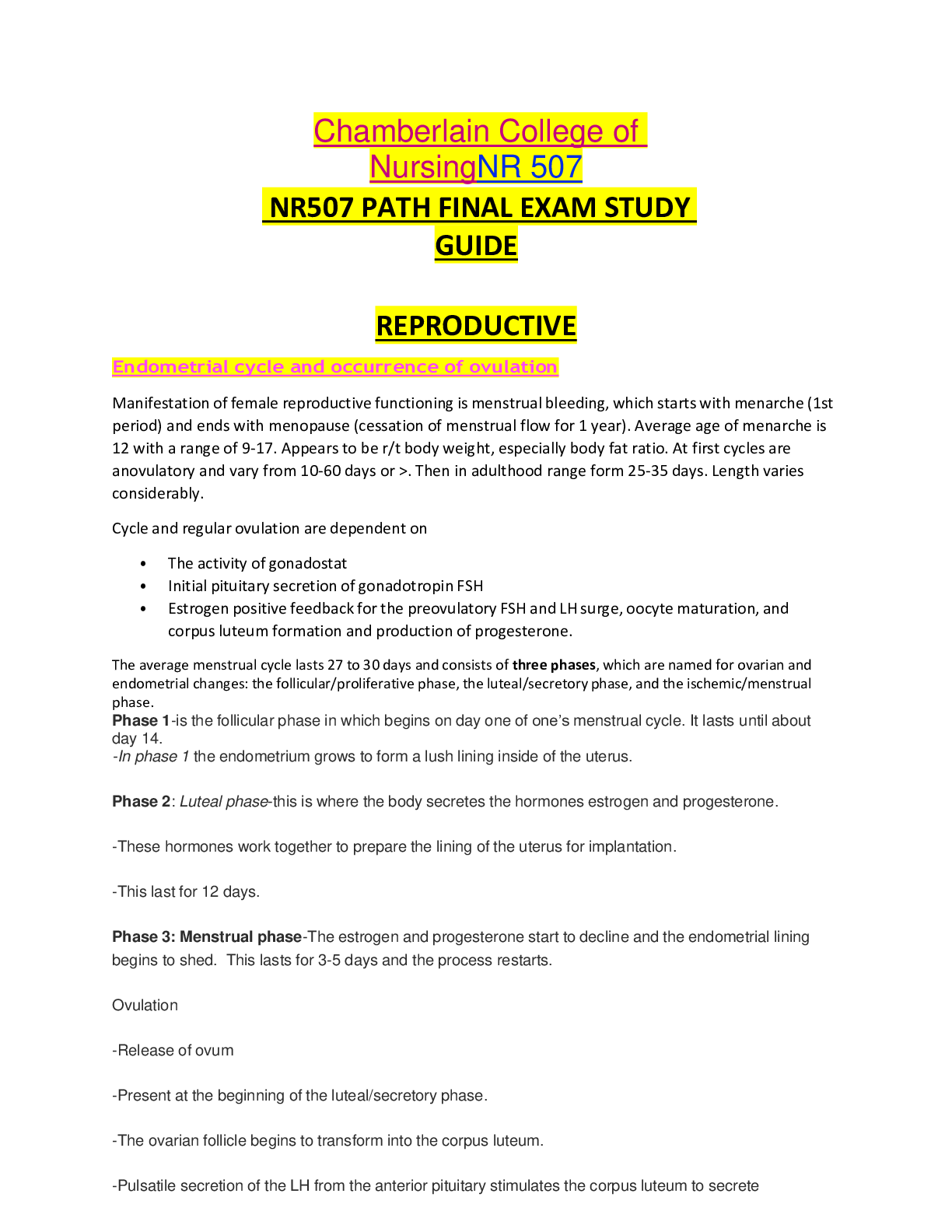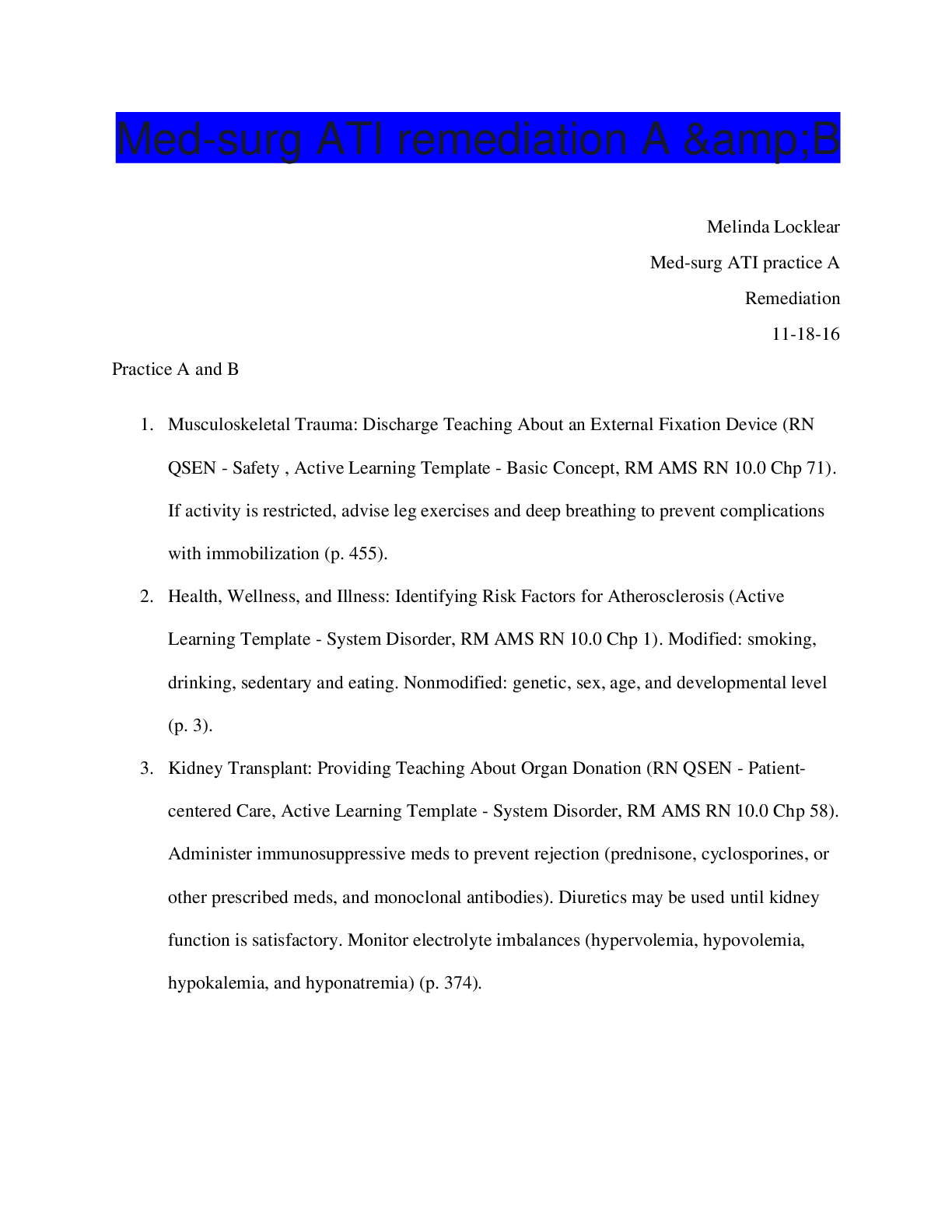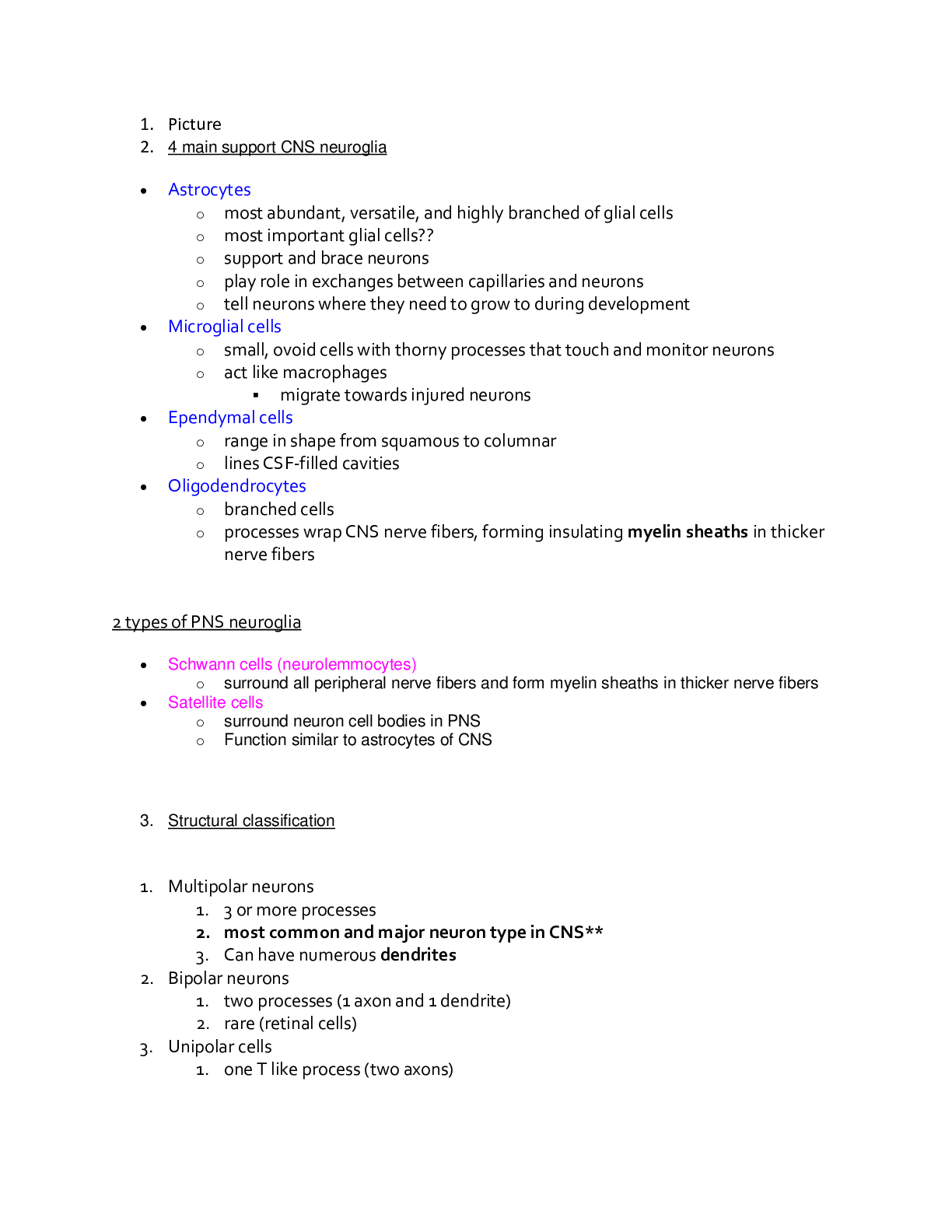Biology > STUDY GUIDE > BIO 181 FINAL STUDY GUIDE, Latest complete guide (fall 2019/2020) (All)
BIO 181 FINAL STUDY GUIDE, Latest complete guide (fall 2019/2020)
Document Content and Description Below
BIO 181 FINAL STUDY GUIDE Lecture #1: 1. How did the four macromolecules appear on early earth? Components of “Primitive Soup” Carbohydrates, Lipids, Nucleic Acids, Proteins (four macromol... ecules of life) We don’t have a clear answer but there are numerous hypotheses. 2. List and explain the basis/background for the four main theories of how life originated on early earth. Are there any challenges these theories have to overcome? a) Oparin-Haldane Hypothesis (tested by Miller-Urey) a. Mimicked atmosphere of primitive Earth i. Reducing atmosphere w/ oceans and lightening (1924 thought that atmosphere was reducing but in 1980 found out that atmosphere is neutral) b. Demonstrated abiotic synthesis of organic compounds c. Results: found 17-20 of amino acids b) Meteorite Hypothesis a. Meteorites that fall to Earth today will often contain amino acids, carbohydrates, and nucleotide bases b. Results: found L and D bases, which are often produced by animals c) Iron-Sulfur World Theory a. Simulated hydrothermal vents using CO (carbon monoxide) and KCN (potassium cyanide) produced amino acids b. Theory: life originated at hydrothermal vents c. Challenges: it is very hot, possibly too hot for cells d. The fourth theory (RNA World) derived from this theory we are still missing lipids i. Potential explanation: lipids formed from minerals underneath vents d) RNA World a. RNA was the precursor to DNA (both enzyme and genetic storage material) b. RNA monomers have been produced spontaneously from simple molecules 3. What does organismal evolution look like across time? (list major evolutionary events and when they happened) Adaptation to the environment over billions years. Coming to deal successfully with changes in: oxygen levels, carbon dioxide levels, temperature extremes (hot and cold), ocean chemistry (pH, salinity, toxic chemicals), water availability, light intensity and spectral qualities, UV radiation. Characteristics of the First Cell: Prokaryotes Anaerobic as there was no oxygen in the atmosphere First came the common ancestor, then 3.8 billion years ago the prokaryotes evolved into two groups: Bacteria and Archaea Common ancestor of all species living today speciated into bacteria then further speciated into archaea and eukarya EXTINCTIONS: There have been five mass extinctions, but diversity has increased End-Permian-Triassic Mass Extinction: 252 million years ago 1. Drop in Sea Level (changed habitat of fauna) 2. Several Volcanic Eruptions (released CO2 which was toxic, trapped heat, decreased O) 3. Floods, Sea Levels increased ii. Who survived? Only bottom-dwellers who could tolerate low O, “suffocation” when there is high CO2 and low O End-Triassic Mass Extinctions – 200 million years ago Rising CO2, falling pH, falling O2 (which is same story as above!) 4. Describe the main characteristics of prokaryotic cells. Simple, single celled organism Lacks a nucleus and membrane-bound organelles Not divided up on inside by membrane walls, instead consist of single open space Majority of its DNA is found in the nucleoid (central region of cell) and typically consists of a single large loop called a circular chromosome 0.1-5.0 micrometers and much smaller than eukaryotic cells “The life force” by Service (2013) questions: 1. In 1967, Colin Pittendrigh predicted that functional protocells would be created within a decade. Why hasn’t this happened? 2. In the early 1990’s Szostak moved away from research on telomeres into the world of RNA catalysts, why was his discoveries in this field so important to our understanding about how primitive life on earth started? 3. What are some challenges the Szortak lab still has to overcome to explain early life on earth? Need Mg2+ to copy template, without it too slow, but it was ripping it apart Kurihara et al. (2015) questions: This is a challenging paper with a lot of field-specific jargon, so let’s try to focus on the big-picture findings of this paper! 1. What was the general goal of this study? To examine/study/prove that the primitive soup “protocell” was a DNA-based cell, not RNA like previously thought. 2. What are the four phases in the self-proliferative cycle of a lab-generated giant vesicle? Ingestion Phase, Replication Phase, Maturity Phase, Division Phase 3. What kinds of environmental parameters are needed to stimulate these protocells to divide? “The mother of mass extinctions” by Erwin (1996) questions: 1. How much diversity was destroyed after the “mother of all extinctions”? What may be some advantages for plant and animal diversity after an extinction event? 2. How long did this extinction last? Was it fast or slow? 3. What percentage of invertebrates disappeared? How did this percentage compare to other extinctions? Which animal groups were hit the hardest? Why? 4. How was plant diversity affected during this time? 5. What do we think caused this mass extinction? What is the order of events that the author thinks brought on this mass extinction? Lecture #2: 1. Please describe the process of endosymbiosis. What is the evidence to support this evolutionary change? Earliest evidence of eukaryotic cells: 2.7 billion years ago How we got mitochondria and chloroplasts, which produce energy for the cell. (Dictionary definition: symbiosis in which one of the symbiotic organisms lives inside the other). It has to do with the evolution of a eukaryotic cell, as does compartmentalization (how we gained endoplasmic reticulum and nuclear envelope). Cyanobacteria started producing Oxygen, which was not a good thing for many organisms Process: Essentially a protobacteria was engulfed by a eukaryotic cell FIRST ENDOSYMBIOTIC EVENT Mitochondria 1) A symbiotic relationship developed between an ancestral aerobic heterotrophic bacterial prokaryote (not an Archaea) and a eukaryotic cell. a. The bacteria could deal with Oxygen and provide ATP for the cell 2) The energy-producing aerobic prokaryote took up residence inside the engulfing eukaryotic cell but was not destroyed 3) The energy-producing aerobic prokaryote eventually became the mitochondrion. 4) Eventually, some of the genes from the mitochondrion were transferred to the nucleus. However, other genes remained becoming the mitochondrial DNA (Humans inherit only their mother’s mitochondrial DNA since only the nucleus of a sperm fertilizes the human egg. SECOND ENDOSYMBIOTIC EVENT Chloroplast 1) Developed between ancestral autotrophic prokaryote (not an archaea) and a eukaryotic cell 2) The autotrophic prokaryote eventually became the chloroplast 3) Eventually some of the genes from the chloroplast were relocated to the nucleus but other genes remained in the chloroplast 4) Occurred after the endosymbiotic event of the mitochondrion as all photosynthetic eukaryotic cell have mitochondria Evidence: the fact that Eukaryotic cells are more closely related to Bacteria than Archaea means they must have a common ancestor - Both Mitochondria and Chloroplast have ribosomes but more closely resemble bacterial ribosomes - Sizes match - Both mitochondria and chloroplasts carry out protein synthesis like bacteria - Both have own DNA but more similar to bacterial DNA (circular) 2. What is a protist? Be specific and detailed - All eukaryotes are protists except fungi, animals, and land plants. - Informal name of mostly unicellular organisms - Most nutritionally diverse - Can be photoautotrophs, heterotrophs, or mixotrophs 3. What are three reasons we should care about studying protists? 1) Protists play key roles in ecological communities a. Protists are found in diverse aquatic environments b. Protists often play the role of symbiont or producer 2) They can cause many dangerous human and non-human diseases 3) They are at the bottom of the food chain, so if the population of protists decreases for any reasons, the rest of the food chain is affected. 4. Describe some of the structural and functional diversity in protists. Heterotrophs: absorb organic materials or ingest Photoautotrophs: have chloroplasts, get food from light Mixotrophs: combine photosynthesis and organic materials 5. Describe how protists move. Three Options: a. Amoeboid motion via pseudopodia (false foot), which is the ancestor movement to muscular movement b. Swimming via flagella (1-2) i. Requires ATP c. Swimming via cilia (short, wave-like) (muscular) 6. Why are dinoflagellates ecologically important? Be specific and detailed. Have two flagella and each cell is reinforced by cellulose plates Cause red tide Very bad Algal bloom blocks oxygen from entering ocean, suffocating wildlife Releases saxotoxin, which is poisonous Shellfish filter red tide so we need to be careful what we eat Apicomplexans: - Parasites of animals and cause some serious human diseases Malaria - Spread through their host as infectious cells called sporozoites - Apical and lets it through 7. Why is Plasmodium medically relevant? Describe its life cycle and effects on host. Plasmodium is the protist that causes Malaria in humans, which is a two-host cycle. Life Cycle: 1) Infected mosquito bites a person, injecting Plasmodium sporozoites into the human 2) The sporozoites travel to the human liver in order to divide 3) Haploid merozoites burst out of liver cells and colonize red blood cells 4) The merozoites divide inside the red blood cells and break out of them, causing symptoms 5) The merozoites turn into haploid gametocytes 6) Another mosquito bites and pick up gametocytes 7) Inside the new mosquito, the merozoites form gametes and the cycle continues 8. What are other diseases caused by protists? Food poisoning, chlamydia 9. Describe the life cycle of a ciliate. a) Feeding, waste removal, and water balance a. Paracecium takes in water, which is controlled by vacuoles periodically expel it through the plasma membrane b. Cilia move food (bacteria) into the cell mouth, where the food is engulfed into food vacuoles by phagocytosis c. Food vacuoles fuse with lysosomes, and waste is released when the vacuoles fuse with a specialized region of the plasma membrane that functions as an anal pore b) Conjugation and Reproduction From the slides a. Two cells of compatible mating align side-by-side and partially fuse b. Meiosis of micronuclei produces four haploid micronuclei in each cell c. Three micronuclei in each cell disintegrate. The remaining micronucleus in each cell divides by mitosis d. The cells swap one micronucleus e. The cells separate f. The two micronuclei fuse g. Three rounds of mitosis produce 8 micronuclei h. 4 become macronuclei i. 2 rounds of binary fission yield 4 daughter cells From my notes (shorter/easier to understand) Conjugation: 1) Two cells form temporary fusion 2) Undergo meiotic events in micronuclei 3) Some dissolve, then micronuclei swap Asexual Reproduction: 4) Separate 5) Micronucleus from both will fuse 6) Undergo several rounds of mitosis cell can separate into daughter cells 7) Ciliates go from 1 to 4 daughter cells 10. Describe the diversity in structure of algae. Golden Algae - Biflagellum, outer container, living cell Brown Algae - Blade, stripe, holdfast o Cells have cellulose and gel that allow it to bend with the waves 11. Why are diatoms ecologically important? Diatoms are algae with unique glass-like wall of hydrated silica They are a major “sink” of CO2, meaning they remove CO2 from the atmosphere to the bottom of the ocean, which reduces the CO2 in the atmosphere 12. How do protists play a key role in communities? - Found in diverse aquatic environments - Often play role of symbiotic producer 13. How will they play a role in global climate change? If protist populations decline due to global climate change, the entirety of the global food chain will be negatively affected, given that protists are located at the bottom of the food chain (consumers feed on protists). There is a direct relationship between higher temperatures and a lower abundance of protists. Lecture #3: Definitions Phylogeny: evolutionary history of a species or group of related species (phylogenetics = history of one species) - The discipline of systematics classifies organisms and determines their evolutionary relationships o Systematists use fossils, molecular, and genetic data to determine evolutionary relationships (Anatomy, Physiology) Cladistics: method of classification that groups organisms by common descent Clade: group of species that includes an ancestral species and all its descendants (a valid clade is monophyletic) Monophyletic: an evolutionary unit that includes an ancestral population and all of its descendants but no others. Also called a clade or lineage. Paraphyletic: A group that includes an ancestral population and some but not all of its descendants. Polyphyletic: An unnatural group based on convergent/homoplastic characteristics that are not present in a common ancestor. (shared trait but no common ancestor) Outgroup: A taxon that is closely related to the taxa being studied, but that diverged earlier; a sister group to the group being studied. Ingroup: The taxa that is being studied and sister group to the outgroup. Sister taxa: Two or more lineages that share a recent common ancestor at the node where their branches meet (sister species = common ancestor speciated into two species) Basal taxon: Outgroup. Usually at the bottom and mostly closely derived to common ancestor. Nodes: The point in a phylogenic tree where two branches diverge, representing the point in time when an ancestral group split into two or more descendant groups. Branch: A part of a phylogenetic tree that represents populations through time. shared ancestral character: a homologous trait, or a trait found in the ancestors of a particular group. There is a similarity in organisms due to common ancestry shared derived character: a homoplastic trait, or a similarity of organisms in different lineages due to natural selection and a pressure to evolve similar traits. Synapomorphies: A shared, derived trait found in two or more taxa that is present in their most recent common ancestor but is missing in more distant ancestors. Useful for inferring evolutionary relationships. Homology: Similarity among organisms of different species due to shared ancestry. (ex: tetrapod’s) Homoplasy: Similarity among organisms of different species due to reasons other than common ancestry, such as convergent evolution. Analogy: Homoplasy due to convergent evolution (example: wings of bat and birds), different characteristics, same function. Hierarchical Classification: Linnaeus introduced a system for grouping species in increasingly broad categories (Domain, Kingdom, Phylum, Class, Order, Family, Genus, Species) Sister Species: Common ancestor speciated into two species Please answer the following questions: 1. What are some of the commonly used traits to build phylogenies? Morphology, DNA, Reproductive mode, etc. 2. What kind of information can we gain from the length of branches in phylogenetic trees? Branch lengths can be arbitrary, but they can also represent time (short branch = extinct), or differences in DNA sequences LECTURE 5 Animal diversity: Body plan and development review questions 1. What are common traits to all animals? Multicellular Heterotrophic (ingest organic materials) Some form of motility (ability to move food through digestive tract) 2. What kind of a phylogenetic group are animals? Monophyletic Choanoflagellates are the outgroup, and Ponifera (sponges) are the basal group of multicellularity 3. Describe similarities and differences between sponges and choanoflagellates. Main difference is that choanoflagellates are unicellular and sponges are multicellular Choanoflagellates are not considered animals but ponifera/sponges are They are both eukaryotic organisms Choanoflagellates only have one cell type Sponges have different cell types, but not multiple tissues Sponges have choanocytes that move flagella so sponge can suck in nutrients and water so they allow it to feed Sponges are multicellular but basal to the rest of animalia 4. Describe diploblastic animals, compare them to triploblastic animals Diploblastic animals (Ctenophores and Cnidarians) differ from triploblasts because in the embryonic development in the germ layer, they just have an ectoderm (exoskeleton) and an endoderm (inner lining of organs) Triploblastic animals have an ectoderm, endoderm, and a mesoderm. All triploblasts have bilateral symmetry 5. Compare and contrast radial and bilateral symmetry. Which groups demonstrate radial symmetry? Who are the bilaterians? Radial symmetry are mostly sessile or planktonic organisms that can be divided into two planes of symmetry (like circular) Bilateral symmetry describes animals that move more actively, and usually have long narrow bodies that are divided equally into two sides and have dorsal, ventral, anterior, and posterior segments 6. Compare and contrast coeloms in animals The way to further characterize bilateral symmetry is by coelums a) Coelumates: have fluid filled space completely lined with mesoderm a. Humans b. Can be protostome or deuterostome b) Aceolumates: have no enclosed body cavity c) Pseudocoelumates: have an enclosed body cavity that is partially lined with mesoderm 7. Compare and contrast protostomes and deuterostomes (include developmental differences as well as subgroups). Has to do with the 8-cell and blastula stage of development (essentially where the mesoderm comes from) Differences: Protosomes PSDM CLEAVAGE/8 CELL STAGE: spiral and determinate cleavage COELUM FORMATION/GASTRULA STAGE: Solid masses of mesoderm split and form coelum FATE OF THE BLASTOPORE: Mouth develops from blastopore (mouth forms first) Deuterostomes DRIA CLEAVAGE/8 CELL STAGE: radial and indeterminate cleavage COELUM FORMATION/GASTRULA STAGE: Folds of archenteron form coelum FATE OF THE BLASTOPORE: Anus develops from blastopore Protostomes: - Ecdysozoans: shed their exoskeletons through a process called ecdysis - Lophotrochozoans: have a feeding structure called a laphophore and have a larva stage called trophophore Deuterostomes: - Echinoderms - Chordates - Hemichordates 1. Describe characteristics and traits of sponges (include subgroups, if any) Sponges Basal group of Animalia --> lack true tissue Sessile, anchored to sea floor live in marine or fresh water Suspension feeders, but some are carnivorous Have choanocytes Why are sponges important? - filter and clean water column - survived mass extinctions - used for bathing, washing - sponge toxins used for cancer treatments important: diagram of water filtration and choanocytes 2. Describe characteristics and traits of ctenophores (include subgroups, if any) Diploblastic Radial symmetry Comb jellies about 100 species have 8 rows separated by fluorescent cilia adults and larvae live in water column Why are they important? - abundant food source to larger predators 3. Describe characteristics and traits of cnidarians (include subgroups, if any) Jellyfish Corals Sea Anemone Diploblastic Radial Symmetry About 10,000 species 1. Anthozoa (sea anemones, corals, sea pens) 2. Hydrozoa (hydrozoans) 3. Cubozoa (box jellies) 4. Scyphozoa (jellyfish) Two body plans: go over diagrams!! a. Sessile polyp --> adheres to the substrate by the aboral end of its body (corals) b. motile medusa --> bell-shaped body w/ its mouth on the underside (does not attach to substrate but moves freely) Cnidocytes: stinging cells - a lot have them which serves for predation and for protection (box jellies eat fish) Go over diagram 4. Describe characteristics and traits of flatworms (include subgroups, if any) Platyhelminthes Flatworms No coelum Protostome Triploblast Bilateral - Undergo triploblastic development because they have to be dorsoventrally flattened, but have no coelom - Unsegmented - Broad, flat body shape - Gastroventricular cavity - Gas exchange takes place across surface and protonephridia regulate osmotic balance - Live in aquatic and/or moist environments - Eat protists - Example: tapeworm 5. Describe characteristics and traits of mollusks (include subgroups, if any) 6. Snails Squids Clams Coelum Bilateral Triploblast Characteristics: 1) Have a foot large muscle at the base used for movement 2) Have a visceral mass contains most internal organs and gill of animal 3) Mantle (outgrowth of shell covers visceral mass) also important because it can make hard outer covering secretes calcium carbonate Four Classes: 1) Bivalvia o Outer shell w/ two parts Two appendages hinged together and made with calcium carbonate Adductor muscle keeps both shells shut Can be hypoxia tolerant o Suspension feeders o Can move which helps w/ thermoregulation o Ex) Scallops have eyes but no brain, are mobile 2) Gastropods a. ¾ of all living mollusks b. have a large muscular foot c. Make it onto land (land shells) d. Most distinctive characteristic: evolutionary process = torsion (mantle twists and anus is on the top of the head) 3) Polyplacophora a. Chitons b. oval-shaped marine animals encased in an armor of eight dorsal plates made up of Calcium Carbonate c. Very strong foot live in tide areas d. Have an appendage called Radula a modified mouth that surves to scrap off algae off rocks 4) Cephalopods a. Squid, octopus, cuttlefish, chamber nautilus b. Active predators c. Well-developed head, eyes, and brain d. Carnivores with beak-like jaw e. Cuttlebone remnant of a shell that cuttlefish have f. Foot = tentacles g. Mantle = what surrounds the animal h. Largest invertebrates i. Ink j. Camouflage ability i. Made up of cell types: 1. Chromotophore on skin 2. Nervous and muscular system innervation for texture, color (highly sophisticated) k. Chambered Nautilus i. Has an outer shell buoyancy (compartments with gas that sink or float which regulate density) ii. Have large brain and eyes 7. Annelids - Segmented worms - Bodies composed of a series of fused rings - Two types o Polychaeta (paddle-like appendages called parapodia that work as gills and for locomotion) o Oligochaeta (earthworms and leeches secrete a chemical called hirudin to prevent blood from coagulating) Build a phylogenetic tree including the groups we have studied thus far and synapomorphies of each. (Study Guide) Animal Diversity Vocab List: Diploblast Radial Symmetry Triploblast Bilateral symmetry Dorsal Ventral Posterior Anterior Coelomates Acoelomates Pseudocoelomates Protostomes Lophotrochozoa Ecdysozoa Deuterostome Germ layers Ectoderm Endoderm Mesoderm Coelom Gastrulation Radial cleavage Spiral cleavage Blastopore Archenteron Indeterminate division Determinate division Lophophore Trochophore Cilia Sessile Gastrovascular cavity Flow-through gut Polyp Medusa Cnidocytes Nematocysts Foot Visceral mass Mantle Radula Chromatophore Tagmata Head Thorax Abdomen Cephalothorax Carapace Cuticle Exoskeleton Endoskeleton Water vascular system Ampulla podium Tube feet Pharyngeal gill slits Dorsal hollow nerve chord Notochord Post-anal tail Gill arches Ectoparasites Amniotic egg 1. Describe defining characteristics of ecdysozoans Two largest phyla: nematoads and anthropoda Named after process of ecdysis: process by which cuticle/exoskeleton is molted Triploblastic Bilaterally symmetric Protostomes 2. Describe traits and defining characteristics of each subgroup of arthropods - Have segmented bodies that are usually organized into regions referred to as tagmata o Head, thorax, abdomen - Have chitonous exoskeleton: molecule Chiton and Calcium Carbonate that harden - Joined appendages - Reduced coelom - Spacious body cavity called hemocoel (w/ open circulatory system meaning no blood vessels) - Most have antennae, some have pincers - All have some type of walking legs DIFFERENT PHYLA - 1. Chelicera o (spiders, daddy long legs, ticks, scorpions, etc) o have clawlike feeding appendages called chelicerae o have cephalothorax and abdomen so two tagmata o ex) Horseshoe Crabs ***********************************CONTINUED********************************* [Show More]
Last updated: 1 year ago
Preview 1 out of 82 pages
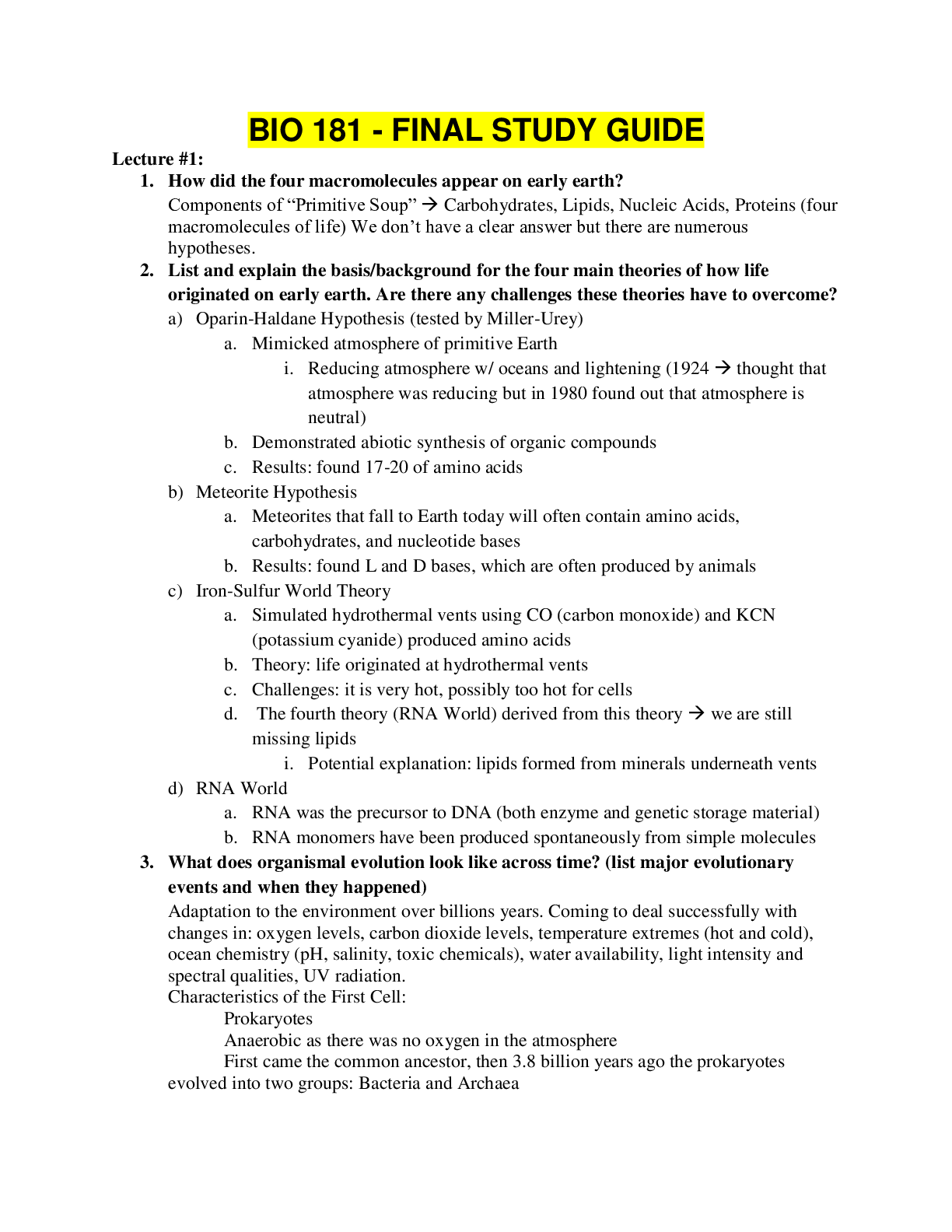
Reviews( 0 )
Document information
Connected school, study & course
About the document
Uploaded On
Sep 25, 2020
Number of pages
82
Written in
Additional information
This document has been written for:
Uploaded
Sep 25, 2020
Downloads
0
Views
36

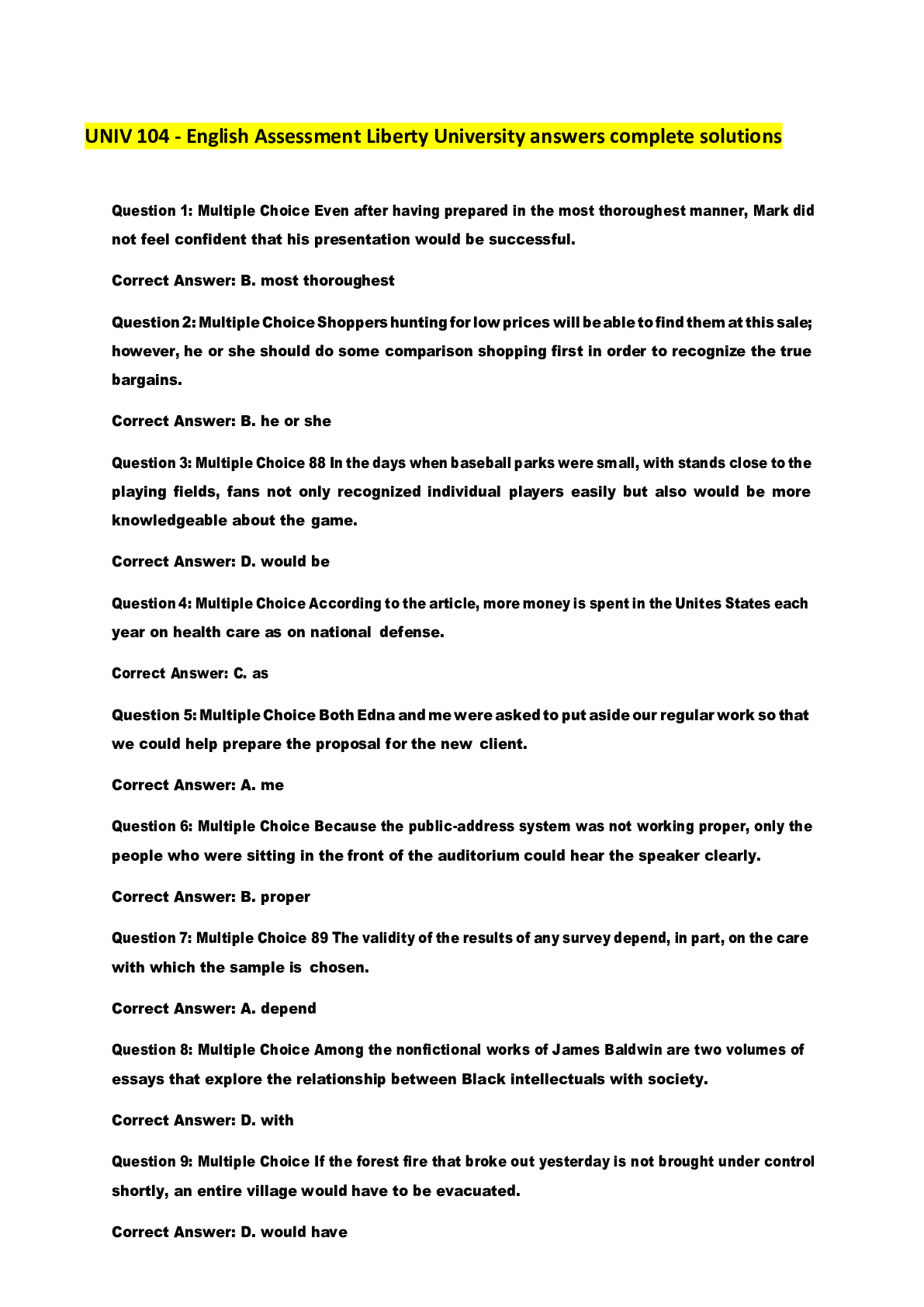

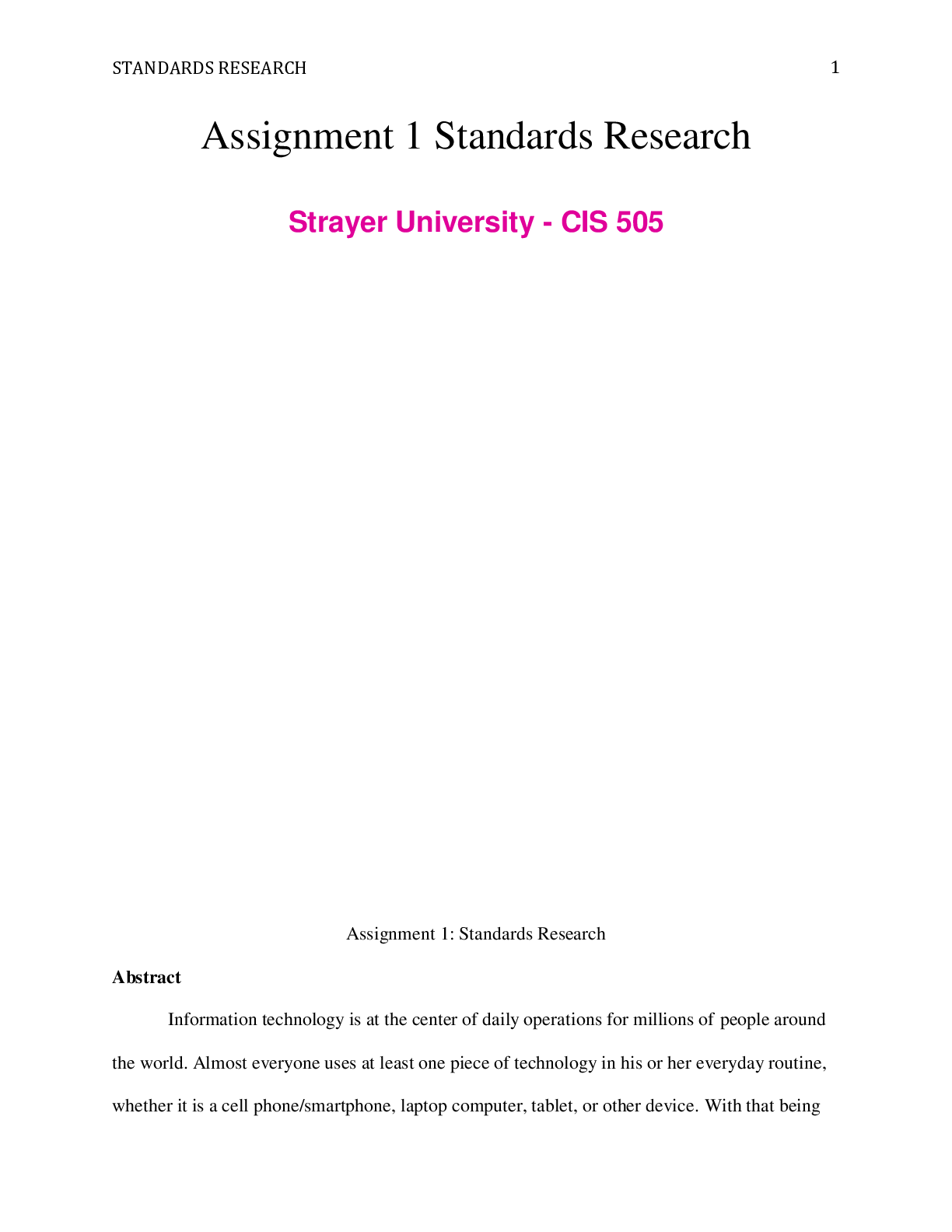
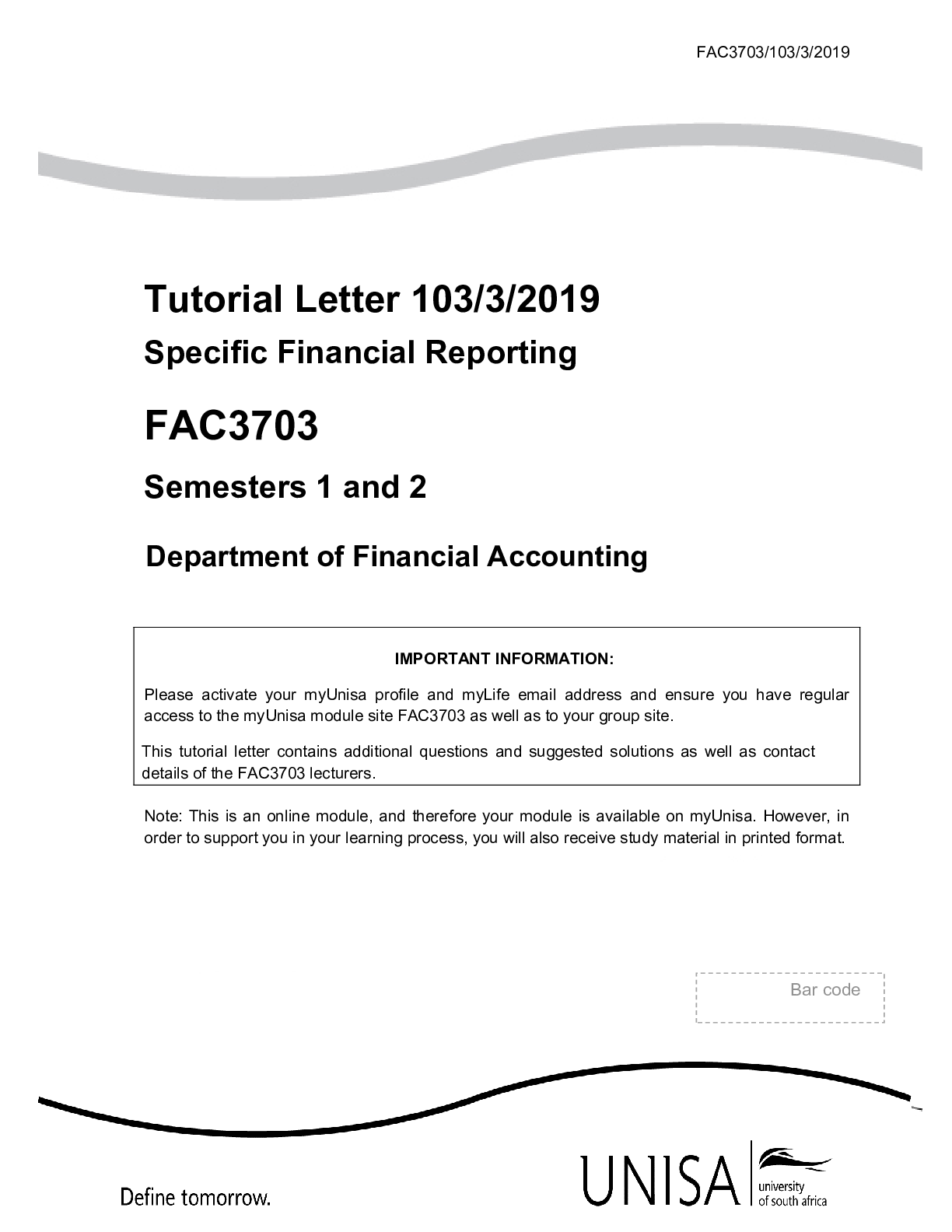
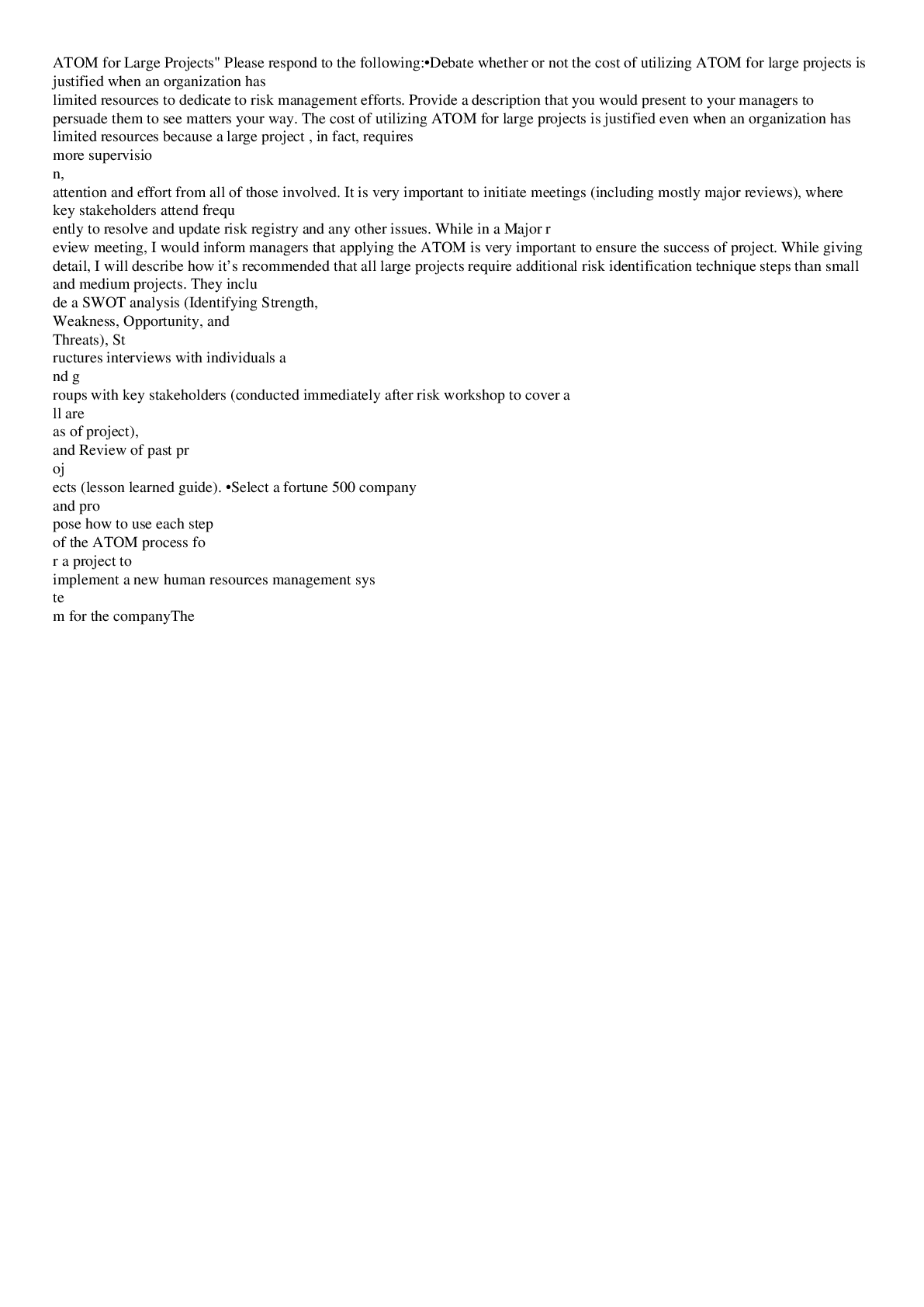

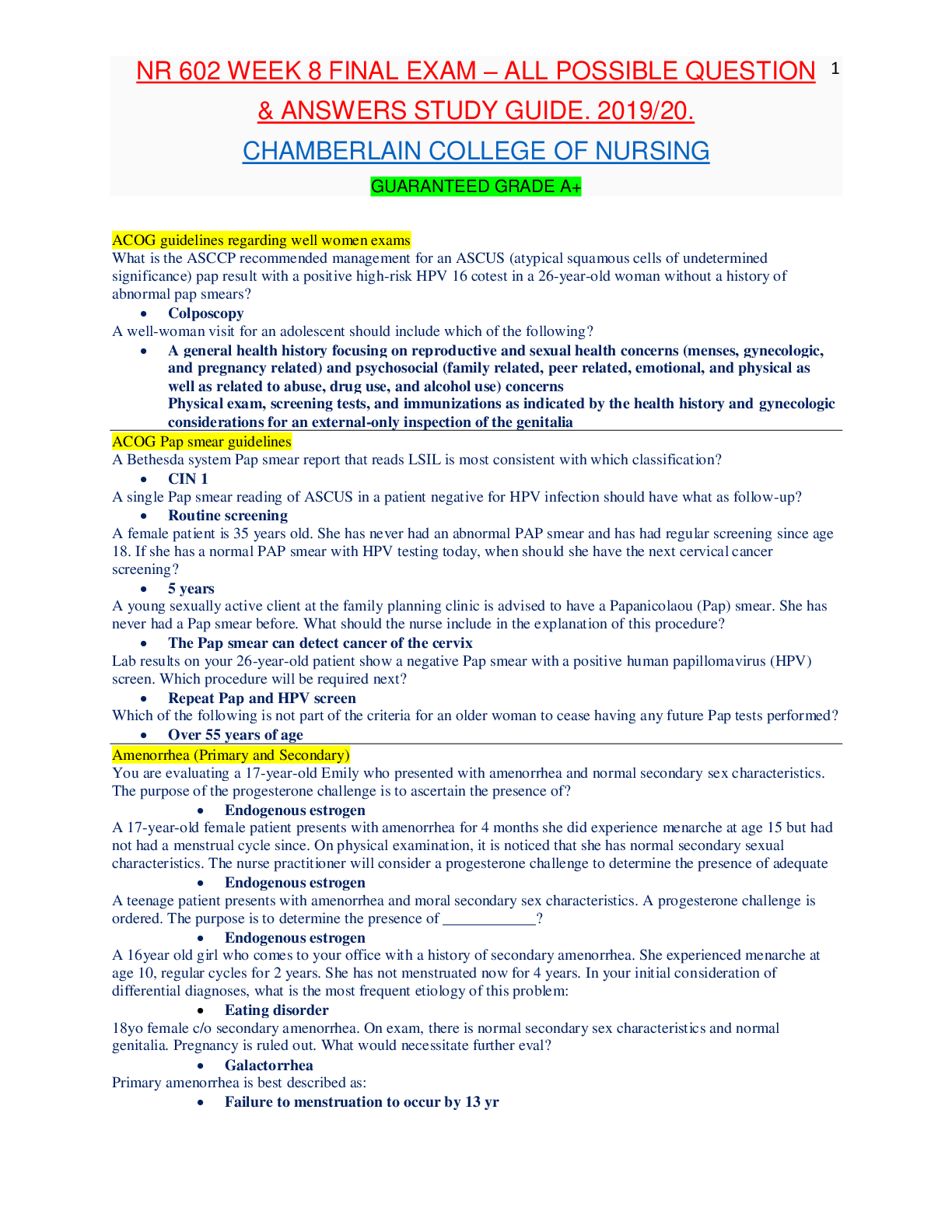
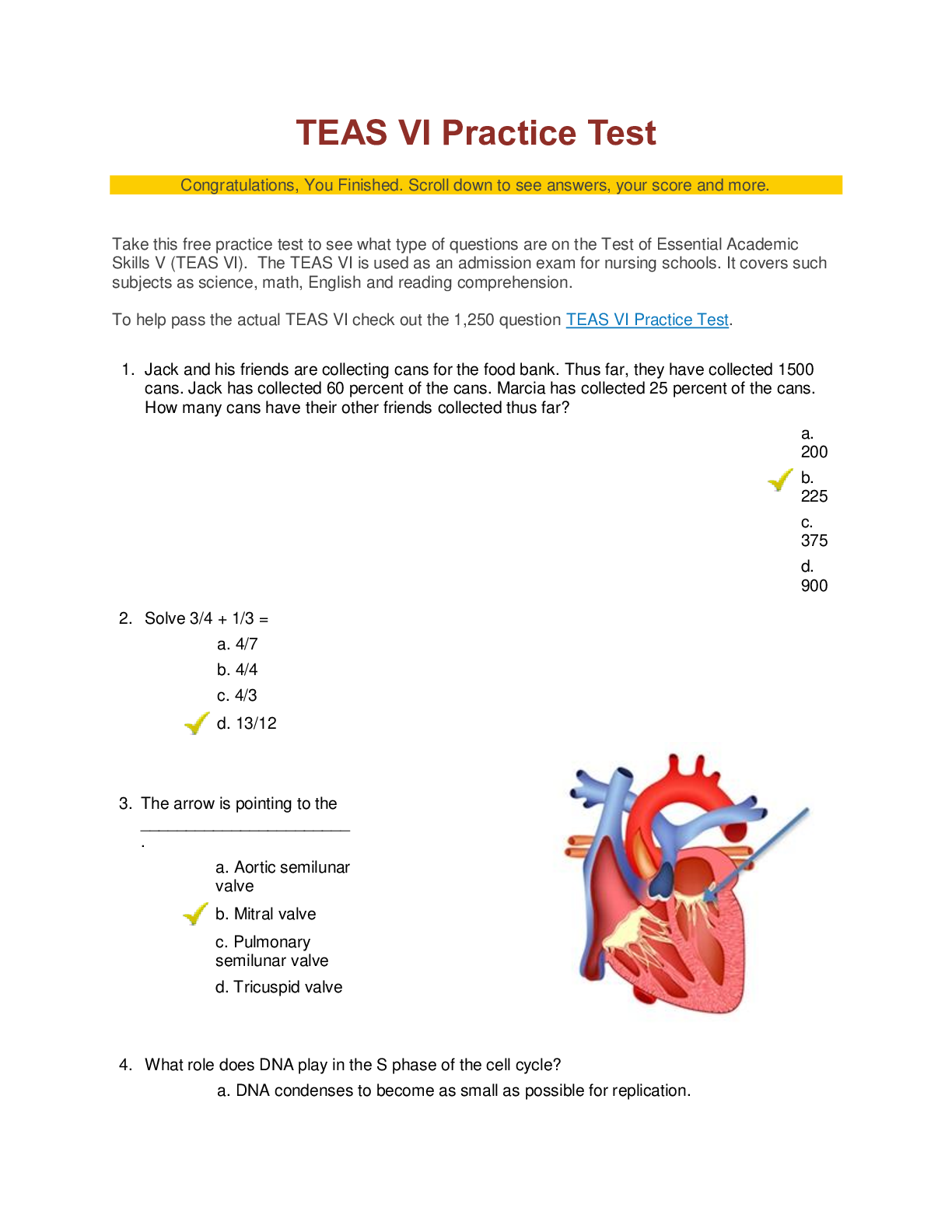

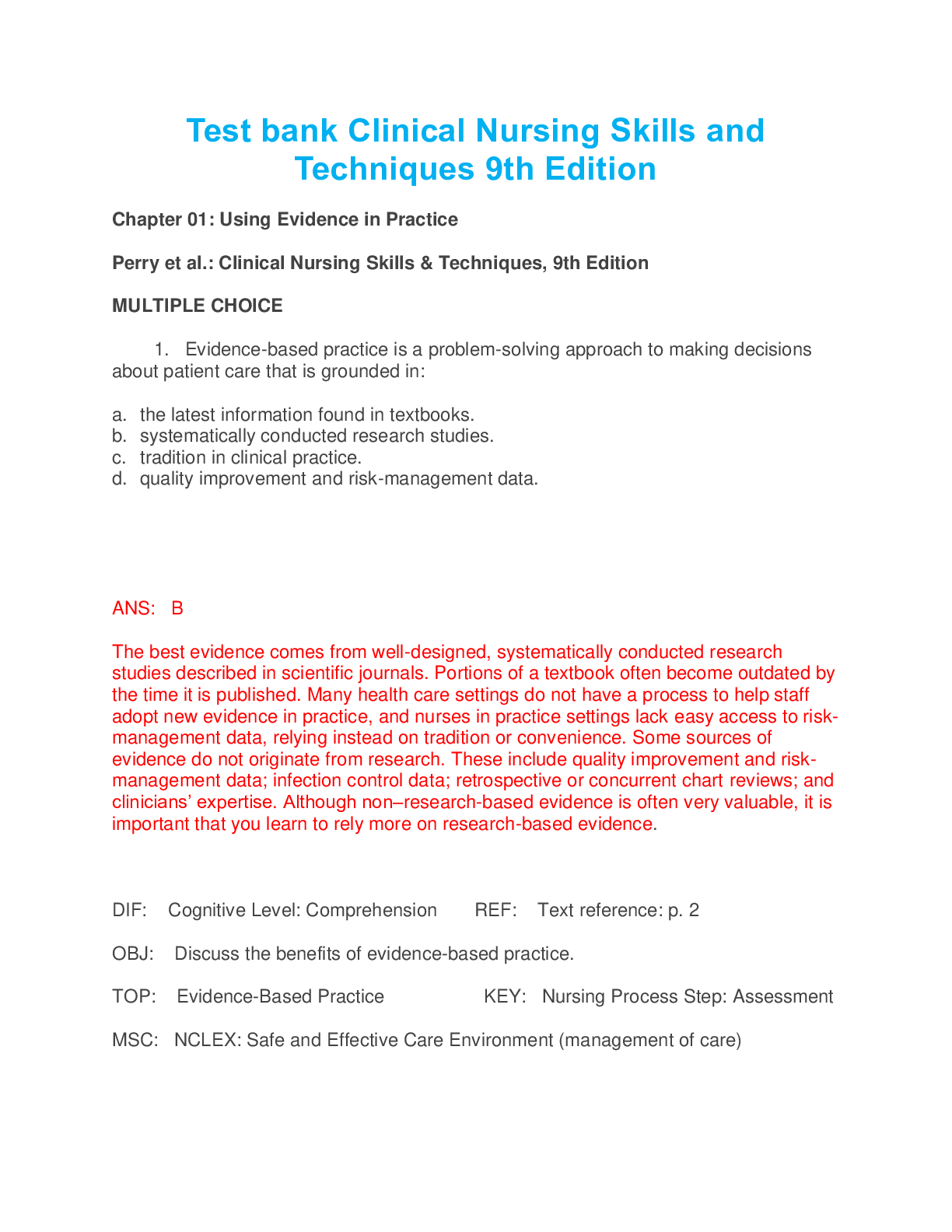
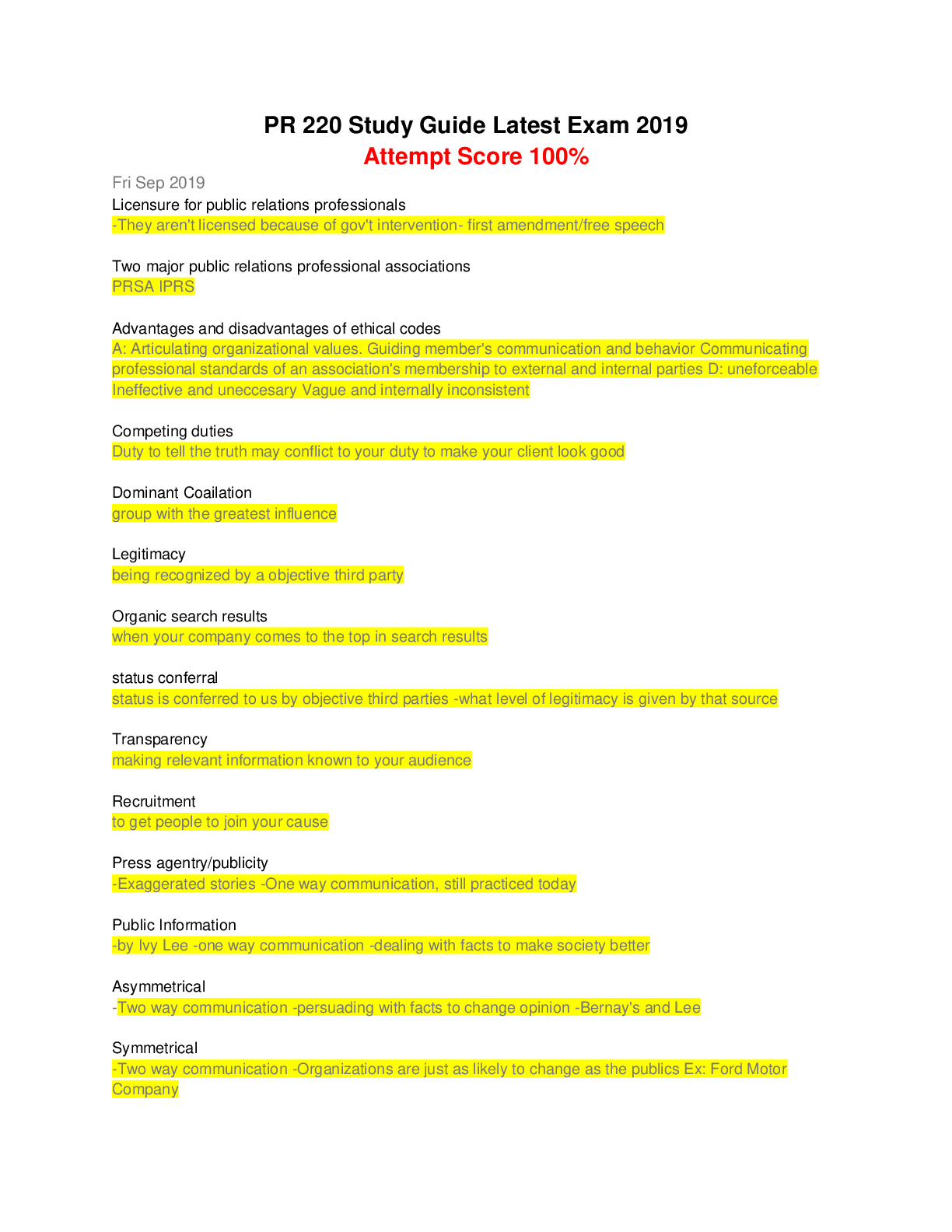

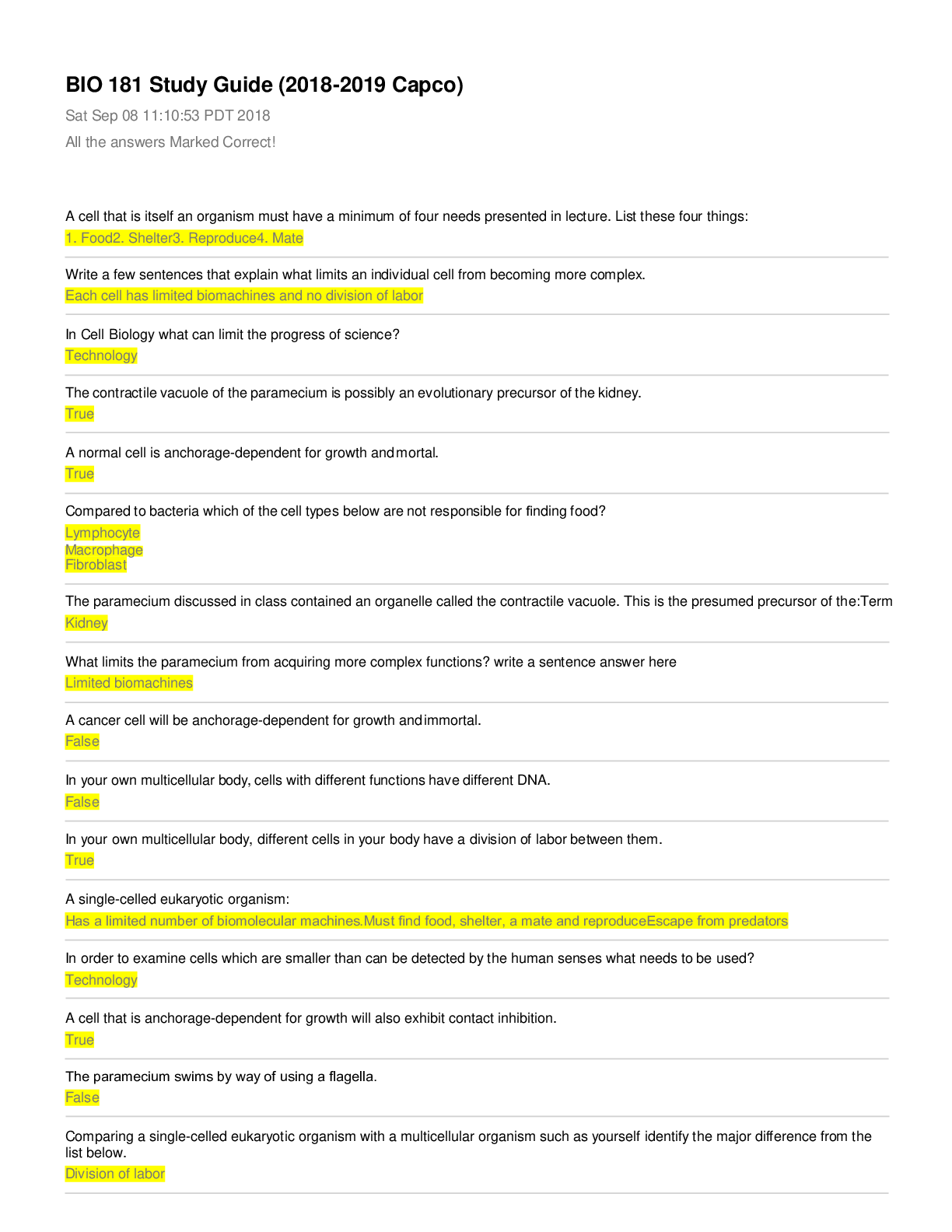
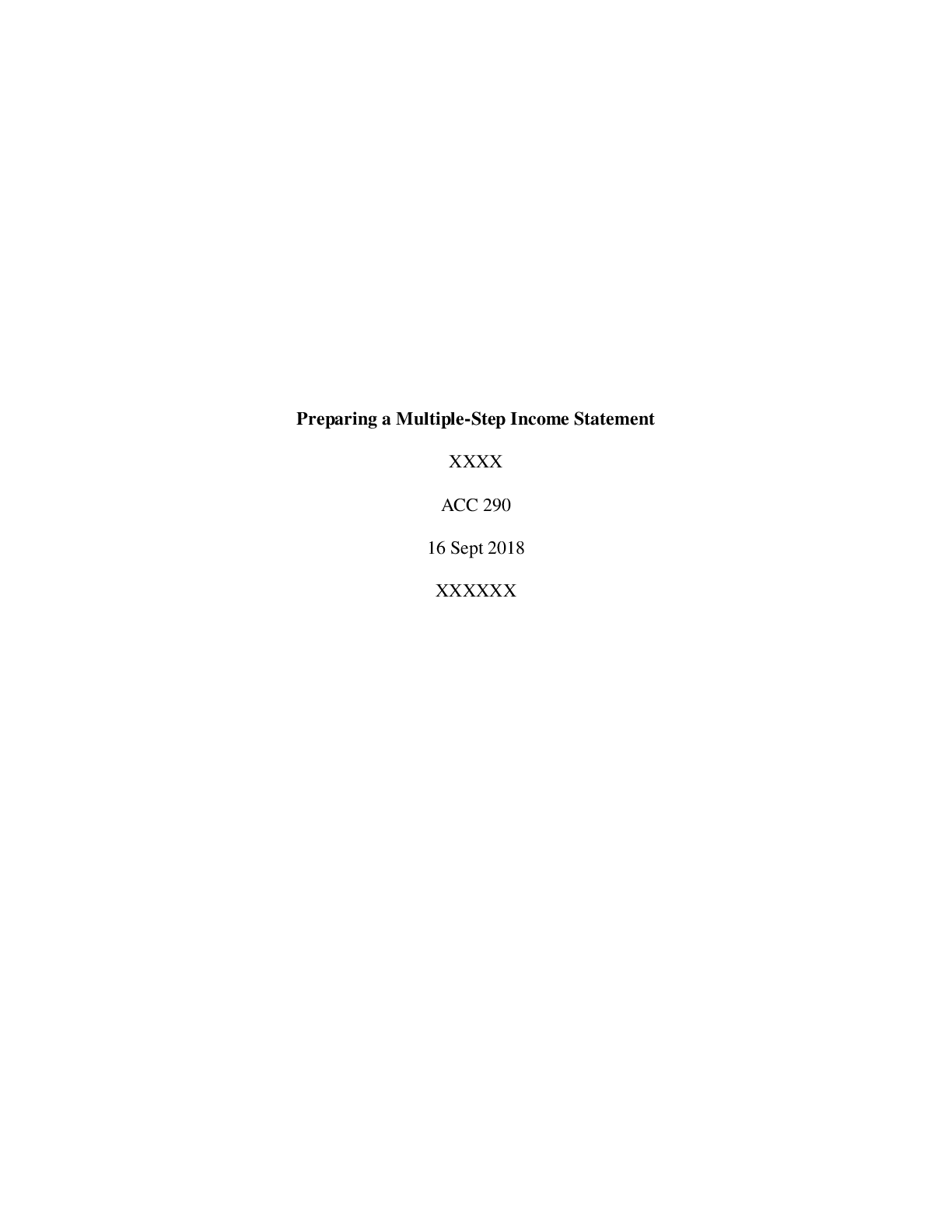
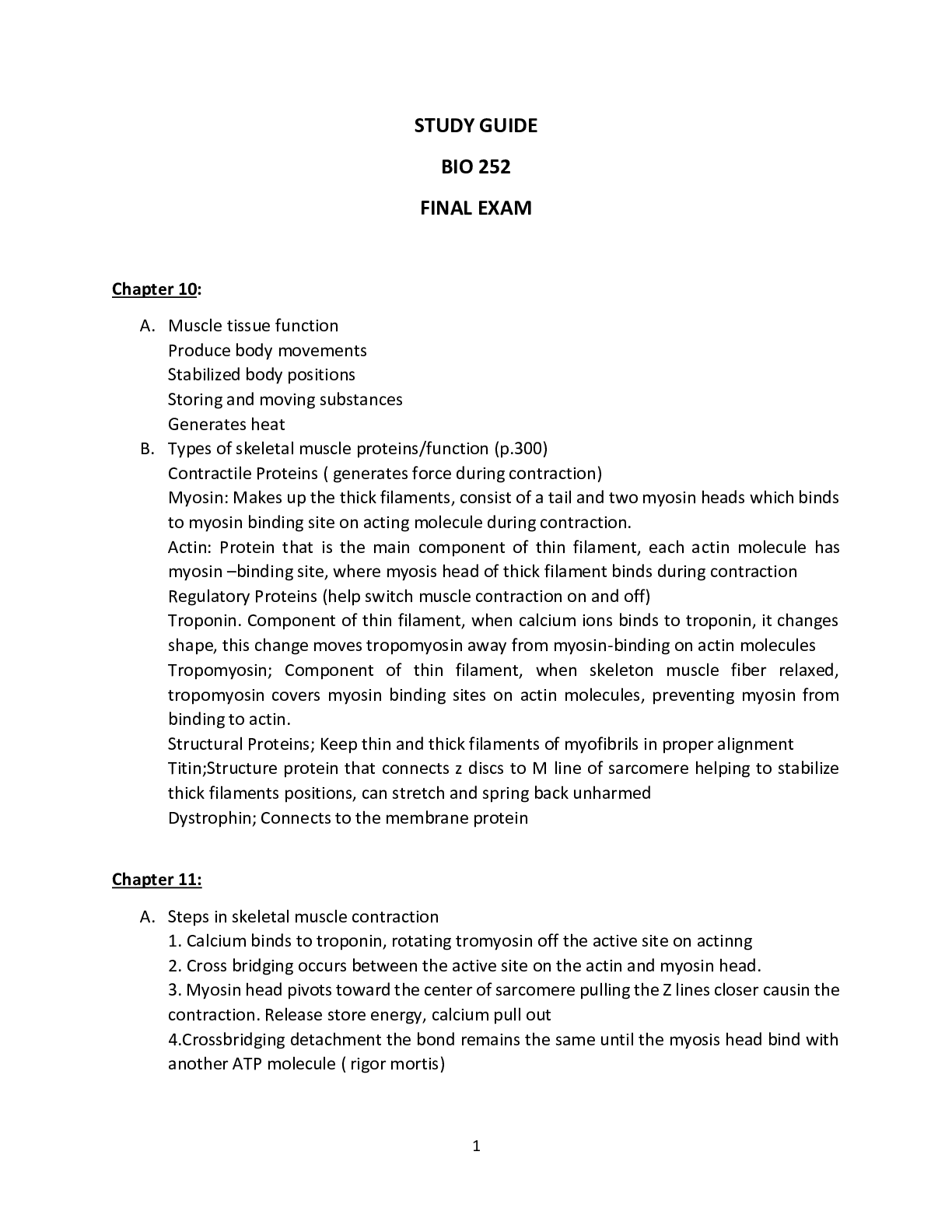
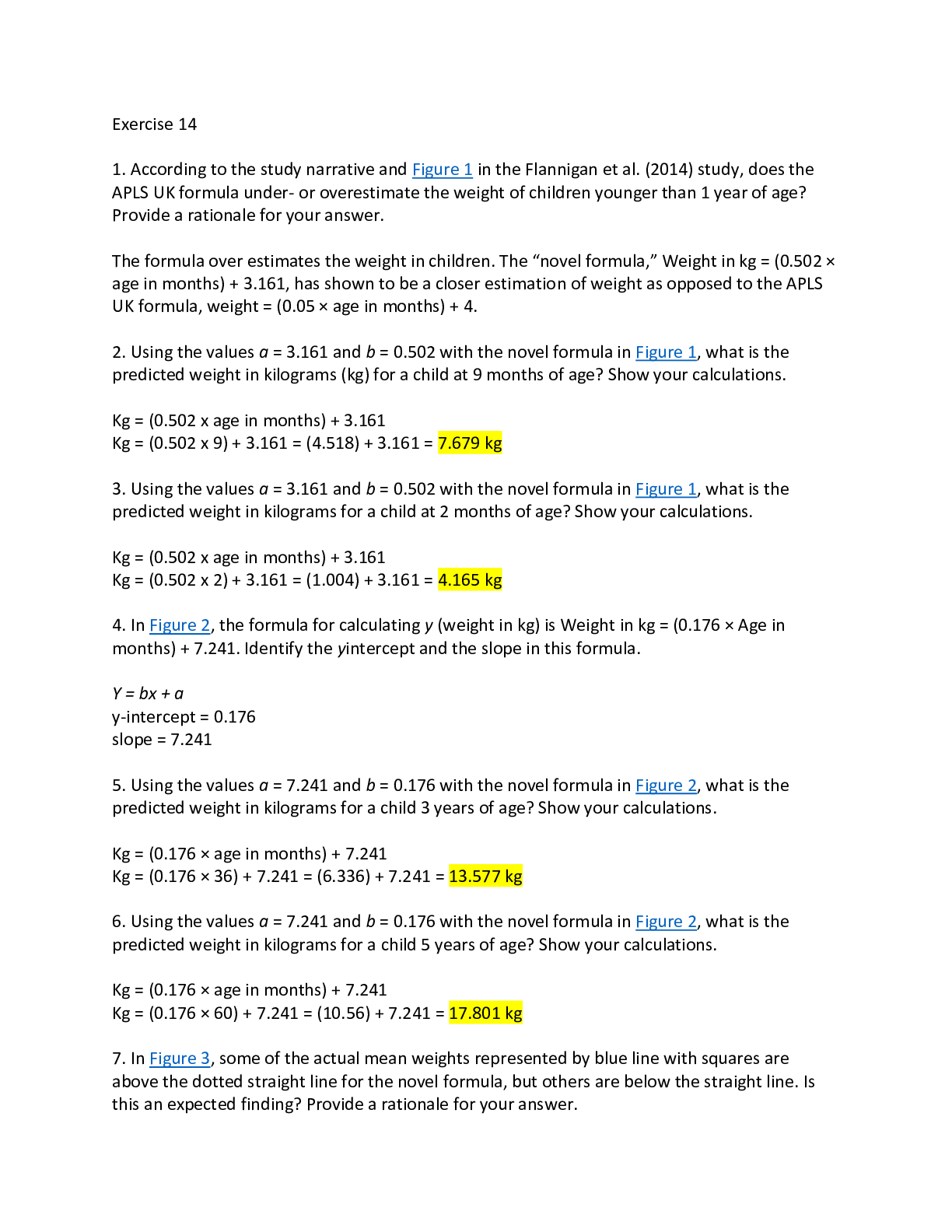
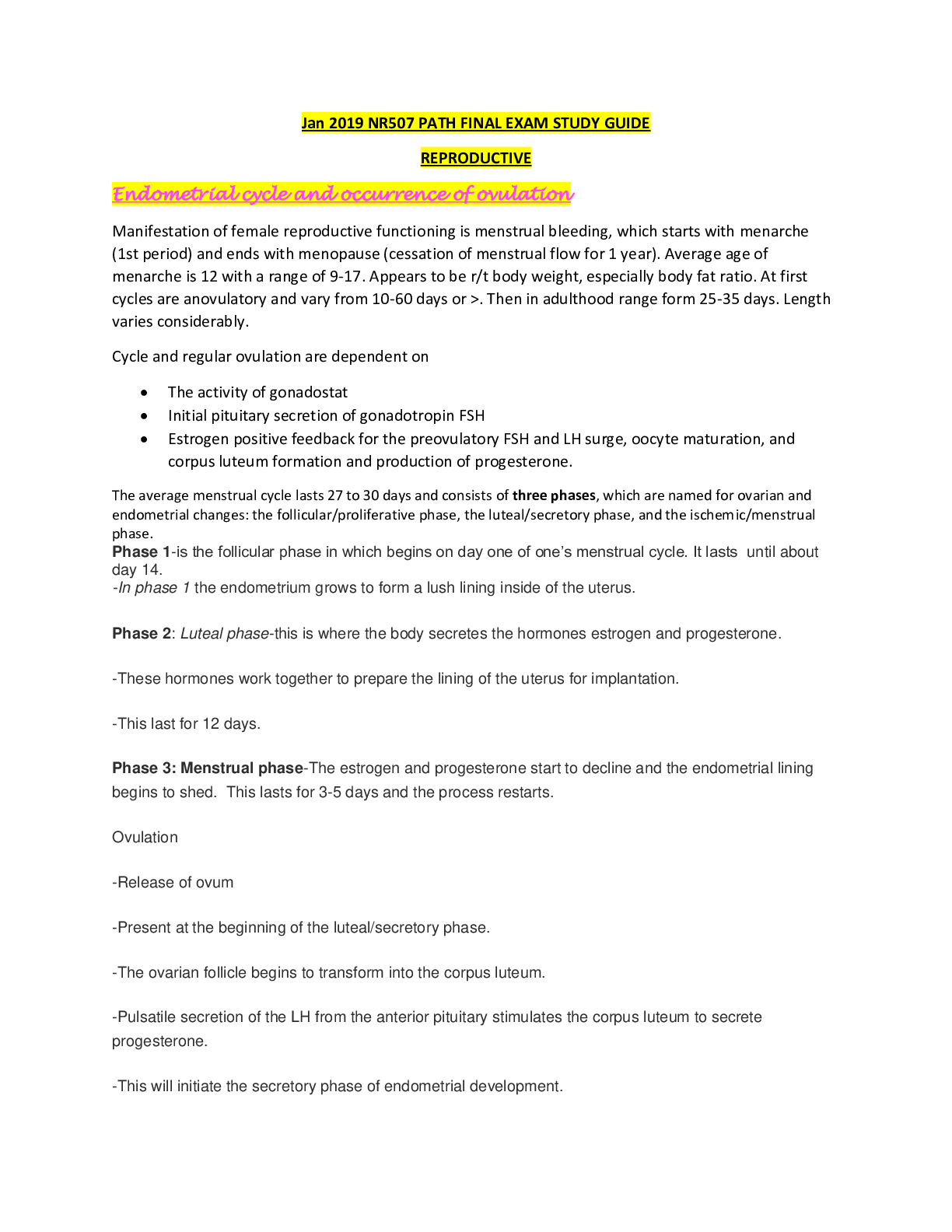
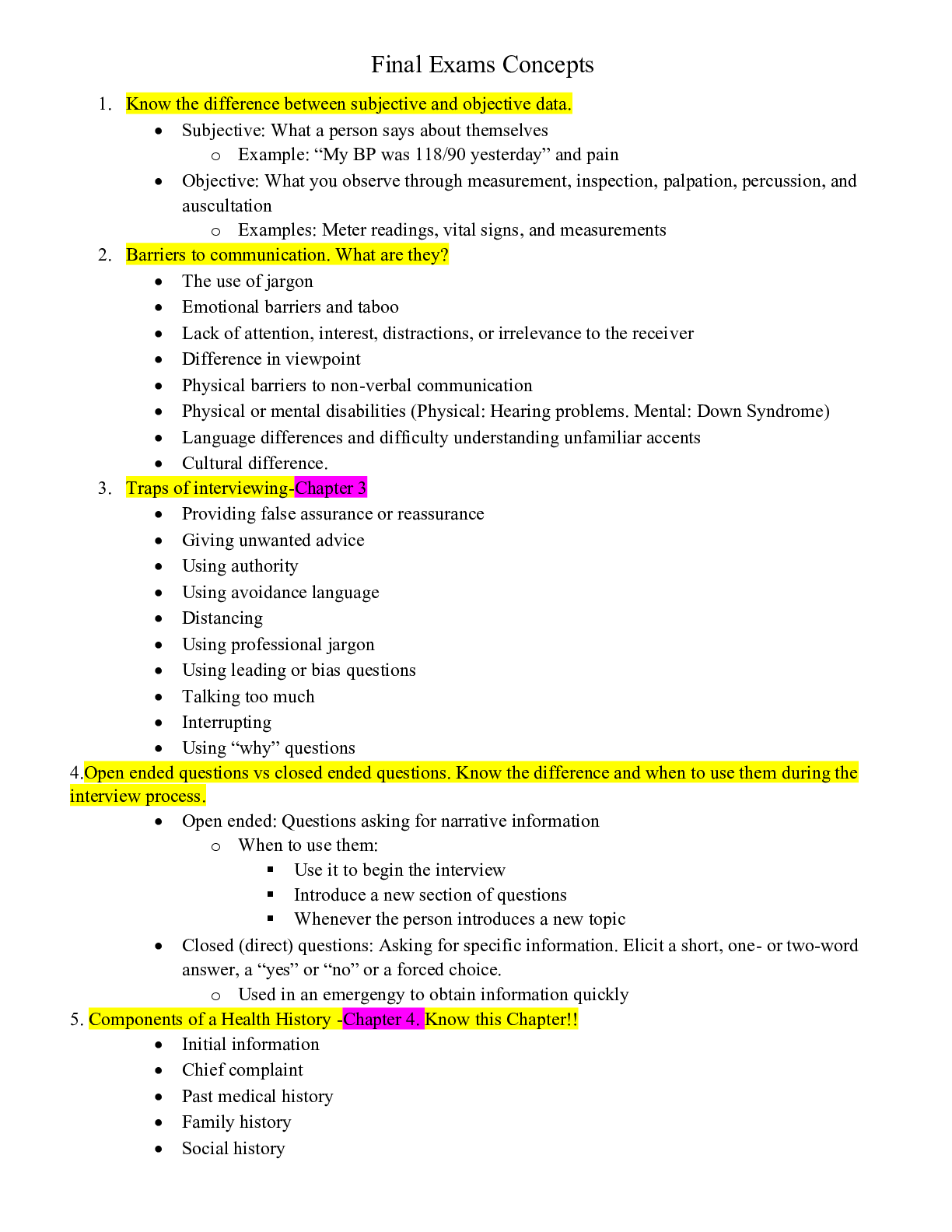
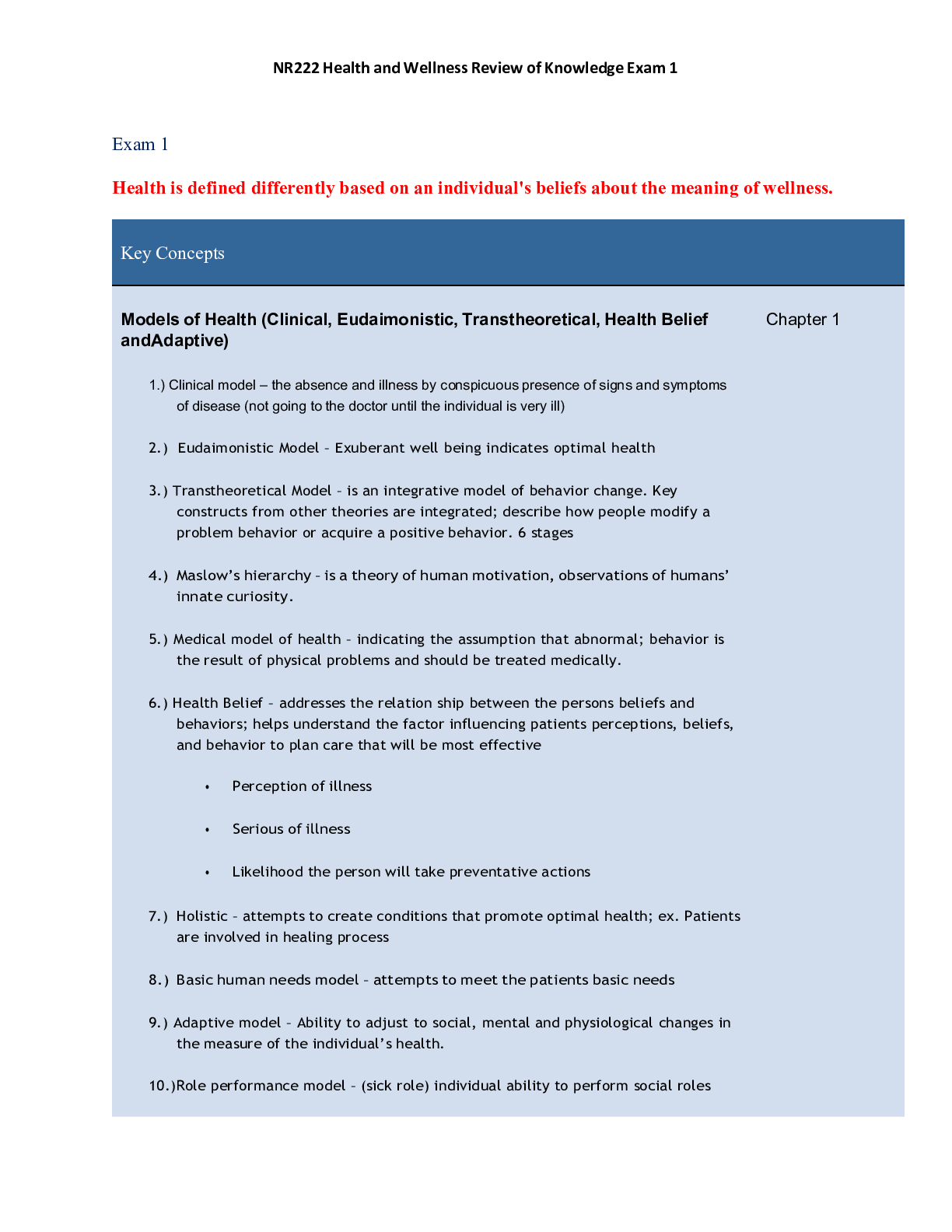
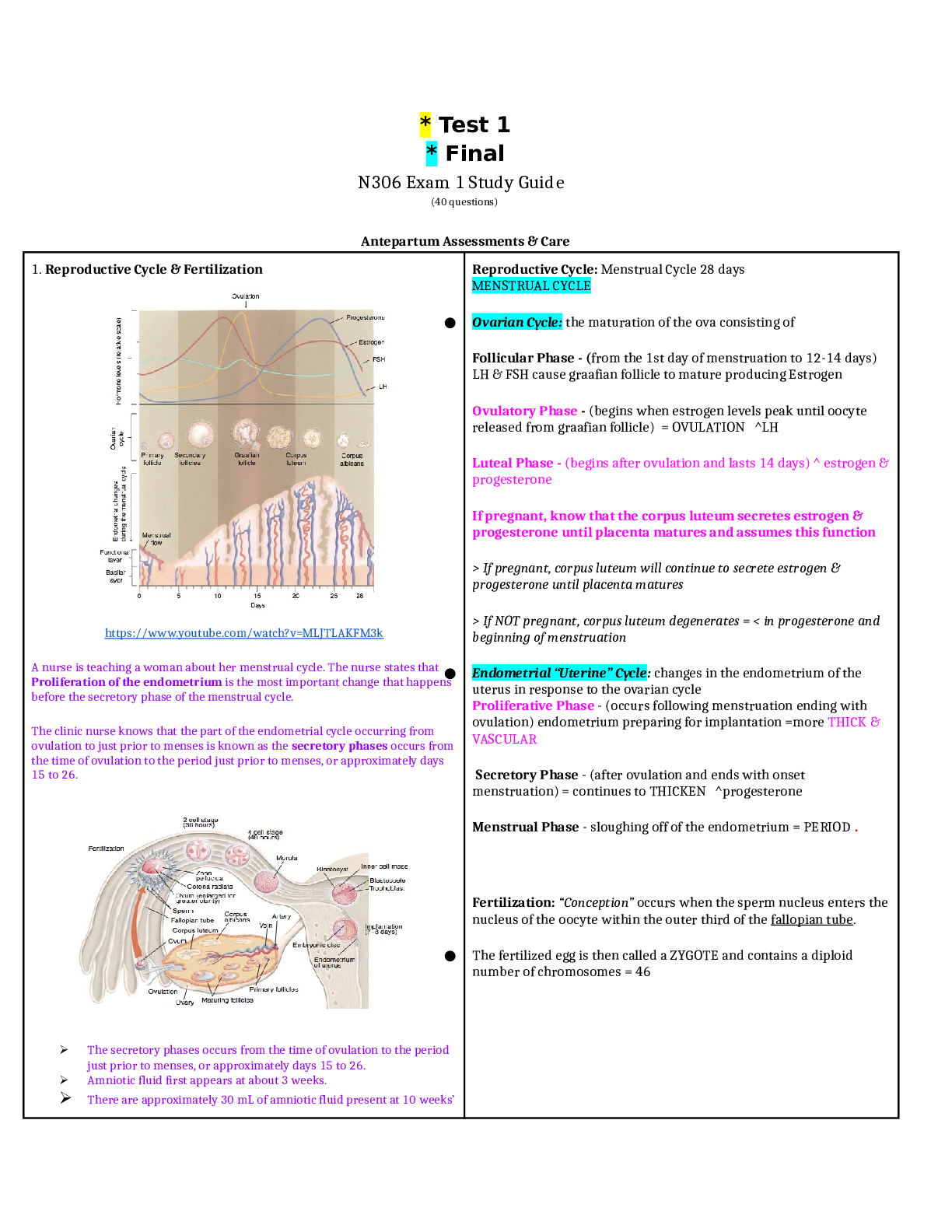
 Correct Study Guide, Download to Score A.png)
 Correct Study Guide, Download to Score A.png)

 Summary Fundamentals of Nursing lectures - Exam 1-3 study guide.png)

